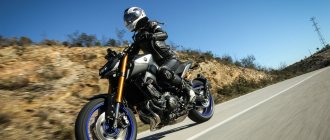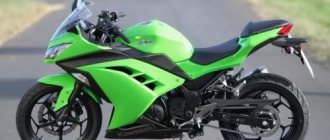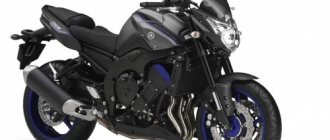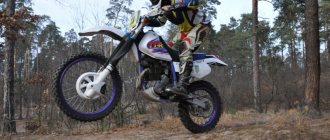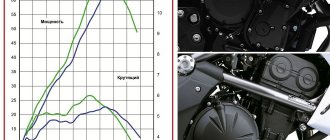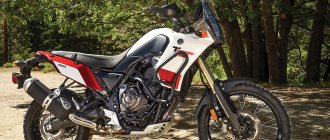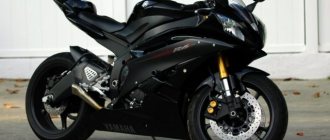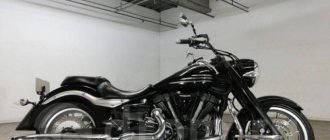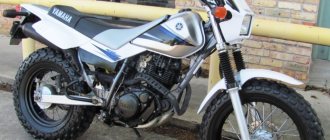001_MOTO_0910_034
Yamaha YBR125: classic, 2004–2010, 123.7 cm³, 10 hp, 117 kg, 40,000–80,000 rub.
Yamaha YBR125: classic, 2004–2010, 123.7 cm³, 10 hp, 117 kg, 40,000–80,000 rub.
It turned out that in order to prepare a dish that can satisfy the gastronomic needs of absolutely diverse and versatile people, ultra-modern technologies and exotic delights of famous restaurant chefs are not at all required. For most, the fundamental principle is still “cheap and cheerful.” How else can we explain that the simple and unpretentious “octagonal” Yamaha YBR125 sold in Europe alone with a circulation exceeding 75 thousand copies? And it’s impossible to count how many of them were sold in Asia and Latin America. Yes, yes, exactly Latin America. After all, the recipe for motorcycle “fast food” appeared in 2000 thanks to the Brazilian branch of the Yamaha Motor do Brasil corporation and was originally intended for the local Spanish- and Portuguese-speaking market: a two-valve single-shaft “single-barrel”, a simple steel frame, minimally sufficient brake mechanisms, simple suspension... Then what do you need! The demand for the Yamaha YBR125 was so great that assembly of the model was also organized in Mexico and Colombia. And in 2003, they were joined by a joint venture with the Chinese company Jianshe Industries Co., Ltd in Southeast Asia. It was from there that the lion's share of these motorcycles subsequently came to Europe. It came to Russia even earlier than European countries - in 2004. In general, various modifications of the Yamaha YBR125 for different markets differ significantly from each other: place of production, plastic hitch, brakes, headlights, wheels, power systems. We were imported exclusively carburetor motorcycles from China with a rectangular headlight and a plastic half-fairing. These are what we will mainly be talking about.
011_MOTO_0910_034
POWER UNIT. A real success for Yamaha designers. The engine has been tested by time and barbaric operating conditions on the roads of the “third world”, and therefore has long been cured of most “childhood diseases”. The owners make up legends about its reliability and unpretentiousness, citing as weighty arguments the hundred and fifty thousand mileage and autonomous circumnavigation of some copies without major repairs. Needless to say, the engine consumes and easily digests almost any fuel and oil. If only the oil itself was changed at least once every 4,000 kilometers. At the same time, the oil-guzzling characteristic of some Yamaha models sometimes appears when the odometer exceeds 35 thousand kilometers, and disappears again with the replacement of piston rings and valve bushings. So it's no surprise that the YBR125 isn't the only bike in Yamaha Motors' slender line-up to use this engine. This list is impressive: XT125R/X, TT-R125, DT125RE, XTZ125E/XE... Some third-party manufacturers (for example, Sherco CityCorp 125) did not disdain the motor.
By the way, wide unification with Yamaha off-road models has one extremely positive side effect: for this engine there are several options for increasing the displacement from the standard 123.7 cm³ to a soul-warming 130–170 cm³. Similar tuning kits (for example, ProCycle, BBR Motorsports or Powroll) include a new cylinder-piston group, a camshaft with extended valve timing and sometimes even a crankshaft with an increased piston stroke. And in order to fully unleash the potential of the engine, you can at the same time install a new Keihin or Mikuni VM26 carburetor with a Ø26 mm diffuser and an engine control unit made by BBR Motorsports, which raises the upper limiter response zone by 1000 rpm. However, you will have to tinker with the release yourself, since the commercially available versions of complete systems for the TT-R125 or XT125R/X on the YBR125 will only fit at the point of attachment to the cylinder head. But the final result should be worth all the pain, because the engine will add about 5-7 “horses” to the existing ten. Some archaic design of the power unit is manifested in the requirement to inspect the thermal clearance of the valves every 6000 km. Neglecting service intervals leads to increased rattling noise from the cylinder head. But you shouldn’t be too afraid: the openness of access to the valves and the simplicity of the adjustment mechanism (screw - nut) make the already simple procedure elementary. But another characteristic noise from the cylinder head should alert you. Due to overheating, it may be necessary to replace crackling camshaft bearings. You can’t delay repairs - the “wedge” of the bearing and the subsequent meeting of the valves with the piston will cost many times more.
In general, bearings marked Made in China are the real bane of the Yamaha YBR125. They do not differ in manufacturing precision, and therefore often fail. For example, some motorcycles have lost bearings in the gearbox after covering a couple of tens of thousands of kilometers. The defect manifested itself in the form of a howl in fifth gear at 5000–6000 rpm. The gearbox itself is reliable without reservations - you just need to change gears correctly, so as not to have to worry about the second one “jumping out”, and to restore the clarity of gear shifting on well-traveled examples, it is enough to replace the pedal return spring.
In addition, when choosing, you should carefully examine the copies produced in 2007–2008, when the Mikuni BS25 “vacuum unit” replaced the proven Mikuni VM22. Unfortunately, the more advanced design did not add any advantages; rather, on the contrary: not only did the power decrease, but this carburetor is also famous for excessively leaning the mixture. When driving for a long time at a cruising speed of around 100 km/h, this leads, at a minimum, to burnt valves and deterioration in dynamics. Therefore, the return in 2009 to the “old friend” Mikuni VM22 (albeit now with fuel heating) was quite natural.
The clutch can withstand a lot even with hard use in motorcycle schools and makes you notice it only after 30–40 thousand kilometers.
Good day everyone! I'm not very good at writing, so don't judge too harshly. I started riding motorcycles in 2001 - at first it was my grandfather’s Minsk, then it was sold in 2002. I switched to my father’s Voskhod Kovrovets, which I rode until 2010. I only went to the village in the summer. After that I didn’t get on a motorcycle, but from that moment I began to think very much about buying my own - something always bothered me, someone was against it... But all the interfering factors eliminated themselves and on May 16, 2013 I became the proud owner of a Yamaha YBR125 2007 release. I called him Worker. Why Worker? Yes, because for me he became a true friend who works for the sake of my freedom. This is almost how I got him:
I'm not very good at writing, so don't judge too harshly. I started riding motorcycles in 2001 - at first it was my grandfather’s Minsk, then it was sold in 2002. I switched to my father’s Voskhod Kovrovets, which I rode until 2010. I only went to the village in the summer. After that I didn’t get on a motorcycle, but from that moment I began to think very much about buying my own - something always bothered me, someone was against it... But all the interfering factors eliminated themselves and on May 16, 2013 I became the proud owner of a Yamaha YBR125 2007 release. I called him Worker. Why Worker? Yes, because for me he became a true friend who works for the sake of my freedom. This is almost how I got him:
Here, however, rubber footpegs from Voskhod, corrugations on the fork and new tires on both wheels have already been added.
I bought the motorcycle from a wonderful man Arthur from Dnepropetrovsk, who moved to Russia for permanent residence, and the motorcycle remained in Dnepropetrovsk. I agreed on the purchase back in August 2012, but Arthur was able to come to Dnepropetrovsk only in May 2013. We met, talked, rode a motorcycle first together, then I myself, stopped at a car wash, discussed everything and the deal took place. Arthur also took out insurance for a year at his own expense and filled the tank full. I consider myself lucky with both the seller and the motorcycle! The odometer at the time of purchase showed 19,450 km. Arthur was the second owner of the motorcycle. Additional options included: heated Saito handles, wind protection for hands, and a cigarette lighter. Among the shortcomings: the absence of a lock on the cover that covers the battery, small scratches on the front fender and muzzle, a torn rubber on the left driver's footrest, a fallen off wire for heating the right handle, bald, cracked rubber on the rear wheel, a small dent on the tank on the left and glued fasteners on the face (the result of a fall at low speed on the left side).
I have had a category “B” license since 2001, and discovered category “A” in early August 2012. Then, in the fall of 2012 and winter of 2012/2013, I was engaged in the selection and purchase of equipment (I’m going to make a post about it later).
On the first day I drove 160 km around Dnepropetrovsk. Thanks to my friend Andrey Default for this.
Immediately after purchasing the motorcycle, I changed the following: - front and rear tires to Mitas H-03 - 2.75 in front and 3.50 in rear - both tube tires, since the wheels of this model were still fitted with tube tires. I also installed new cameras. Photo of tires after 6000 km: Front:
Rear: — Engine oil is Motul 5100 10w40 — in the future I changed the oil at least 3000 km and only for that.
At 20,300 km: — I replaced the seals and anthers of the front fork - the left blade was sweating a lot. After the change, the deficiency disappeared. — Installed corrugations on the front fork. I burned four holes in each corrugation with a hot nail, secured the top of the corrugation with plastic ties, and the lower part of the corrugation sat tightly on the glass.
— Changed the oil in the front fork to Motul Fork Oil 15w - harder. The fork stopped pecking when braking with the front brake and I began to ride more comfortably. — Changed the front brake pads to EBC TT organic with carbon. The original Yamaha ones were there, it was still possible to ride them, but I decided to change them anyway. I am completely satisfied with the pads - they brake excellently in dry hot weather and at +4 and in heavy rain. — I changed the tires on the driver’s footrests to Voskhod ones.
At 24,600 km: — Replaced both sprockets and chain with a Regina O-Ring set. The chain immediately tightened to the 2nd division. I liked the driving sensations after installing the new chain. Let's see how it goes. In 1000 km I haven’t pulled it up even once.
— I changed the damper of the rear sprocket - it started to play a little, after changing the play it disappeared. — Changed the spark plug to NGK Iridium. I just changed it and that’s it - there were no prerequisites. The driving sensation has not changed :).
In addition, during the season the following were installed: — A luggage system from craftsmen from Kharkov. The SHAD platform from the 42-liter Moto-Detail case and the case itself were installed on it.
View with the case: — Round headlight with Wesem optics, 55/60 Watt halogen, protective yoke for the round headlight from the same craftsmen from Kharkov — Puig wind deflector. I had to make new fastenings because the windshield did not fit on the standard ones, as I wanted. — Protective arches from the same Kharkov craftsmen. Thank them very much. I installed the roll bars at the very end of the season, although they wouldn’t have hurt me earlier, when I fell twice (once in the rain I overbraked in the city, and the second time on Tarkhankut my front wheel got into a trap of stones and fell on its side). — Stickers on the tank to protect against scratches by the bag and knee pads. — I completely switched the tidy and front marker to diodes. The visibility of the backlight and display has become much better, even in bright sunshine...
— Puig wind deflector. I had to make new fastenings because the windshield did not fit on the standard ones, as I wanted. — Protective arches from the same Kharkov craftsmen. Thank them very much. I installed the roll bars at the very end of the season, although they wouldn’t have hurt me earlier, when I fell twice (once in the rain I overbraked in the city, and the second time on Tarkhankut my front wheel got into a trap of stones and fell on its side). — Stickers on the tank to protect against scratches by the bag and knee pads. — I completely switched the tidy and front marker to diodes. The visibility of the backlight and display has become much better, even in bright sunshine...
Among other things, I purchased: — An excellent set of Rothewald tools.
— A tank bag for 18-25 liters and a waterproof bag from Louis for 50 liters. They can be seen in the first photo. — Two spider nets and elastic bands with hooks for securing luggage.
This is how I went to Crimea (later I promise a post about this trip):
This is the general appearance of the motorcycle at the moment:
I lubricate the chain every 300-500 km with Motul lubricant. Incomplete chemical kit for motorcycle maintenance:
I love my motorcycle very much and try to take care of it so that it never lets me down because of my oversight... During the season I managed to drive a little more than 6,000 km, now the odometer shows 25,624 km. I traveled to Zaporozhye several times, visited my parents in a village near Krivoy Rog many times, was in Berdyansk, Kakhovka, Evpatoria, Sevastopol, Simeiz, Ai-Petri, Tarkhankut... But more on that another time.
I also want to say a huge thank you to Andrey Default for giving me many answers to questions about motorcycle maintenance, proper riding, handling, for showing me the wonderful karting track in Dneprodzerzhinsk, where I practiced riding, and for much, much more. . By the way, here is a short edited video from my drive through this karting track:
The last departure was October 20, 2013. I stopped by the car wash, filled the tank full, washed it, lubricated the chain, drove the Worker into the garage, carefully covered it and left it waiting for me until spring.
Future plans for the motorcycle: — Changing the battery — I already have a new one at home, I’ll change it at the beginning of the next season. — Changing the turn signals to diode and small ones - I’ll be smart, so that it’s clearly visible and they’re not far from the body of the motorcycle. - Increasing the height of the windshield by at least 10 centimeters - its height is not enough for me now. — Purchase of side fabric cases. — Changing the brake light to a diode one. — Changing the pendulum bushings to bronze ones. — Changing hand protection to protection from Acerbis or similar.
I really like the motorcycle: - maneuverable - don’t mind traffic jams. — economical — powered by gasoline vapor — consumption over 6,000 km was 2.7 liters per 100 km. - easy - you can pull it out of a deep rut on your own. - obedient - goes where you direct him. - my maximum speed was 125 km/h - from a hill and with the wind at my back - the cruising speed would of course be a little higher - 85-90 km/h is not enough, at least 95-100 km/h. — with my 178 cm and 84 kg, it’s very comfortable for me.
— economical — powered by gasoline vapor — consumption over 6,000 km was 2.7 liters per 100 km. - easy - you can pull it out of a deep rut on your own. - obedient - goes where you direct him. - my maximum speed was 125 km/h - from a hill and with the wind at my back - the cruising speed would of course be a little higher - 85-90 km/h is not enough, at least 95-100 km/h. — with my 178 cm and 84 kg, it’s very comfortable for me.
Overall, I am VERY happy with my Worker and love him, and he pays me back in kind...
Thank you for your attention!
006_MOTO_0910_034
Stylish is only available for “Europeans” with a round headlight.
Stylish is only available for “Europeans” with a round headlight.
UPGRADES TABLE
| Years of manufacture | Major design changes |
| 2004–2006 | “simple” carburetor with cylindrical throttle Mikuni VM22SHshort gearshift pedal |
| 2007–2008 | Mikuni BS25 vacuum type carburetor; the ergonomics of the model have changed slightly to make it more convenient for tall drivers; the length of the gear shift pedal has been increased |
| 2009–2010 | new 5-spoke wheels for tubeless tires new front brake caliper low beam always on a return to the “simple” Mikuni VM22X1 carburetor, but now with fuel heating side stand sensor |
CHAIN. With unenviable regularity, sometimes after 5000–8000 kilometers, you have to change the original chain, which, taking into account the not very outstanding power of the device, is a very modest result. To prevent the price tag for the original spare part from making holes in the family budget, many are trying to find a replacement for it in the form of “Java” Favorit chains. But, as practice has shown, they “live” even less, and there is simply no point in installing them, despite the rather humane price list. The surest option is to install an O-Ring type chain, as on the 2009-2010 modification, or an X-Ring from a renowned manufacturer, which will reliably serve for at least 15,000 kilometers.
CHASSIS. There is no need to expect revelations here. It copes with its direct purpose—to move from point “A” to point “B”—tolerably well. Fortunately, no one demands anything else from her. When purchasing, you should pay attention to the alignment of the wheels - there have been cases where the frame came out of the factory gate deformed. The rear shock absorbers, although they last a long time, are designed, rather, for a skinny Chinese worker, which is why they often break. The situation is saved by replacing them with more energy-intensive “non-original” ones. The seals in the front fork suffer, often giving out at around 3,000 kilometers. To somehow increase their life, it is enough to install rubber corrugations on the fork legs (suitable from “Pilot”). The pendulum bushings (they begin to creak at 8,000 kilometers) and the rear wheel axle (after 20 thousand kilometers simply bend in an arc) cannot withstand domestic roads and increased loads. However, while there are still smart turners on the territory of the ex-USSR, it will not be difficult to agree on the production of a new axle that is stronger, from 30KhGSA steel. Against this background, the reliability of the steering column bearings will pleasantly surprise you - they “nurse” for at least 40 thousand kilometers. The bearings in the rear wheel have approximately the same service life, and in the front - twice as long.
BRAKES. A single front brake disc with a single-piston floating caliper at the front and a rear “drum” are just enough for the dynamic capabilities of the car. At the same time, installing a reinforced hose only adds sensitivity to the front brake, without affecting the overall efficiency.
ELECTRICAL. Usually does not create problems. The most common complaints are about the luminous flux produced by the original headlight: the near one illuminates a small spot in front of the motorcycle, and the distant one snatches road signs from the darkness, but not the road itself. The adjustment range is not enough to lower the headlight to the desired angle. Replacing a standard 35W/35 lamp with a similar, more powerful one only partly solves the problem of lack of light: due to a weak generator, in this case the battery is intensively discharged, especially when driving within the city.
ACCESSORIES. Among the factory additional equipment, only arches that protect the engine are available to Russian buyers. When dropped, they cope with their task tolerably - the engine remains intact, but the fairing with the headlight built into it and the instrument panel suffer. Craftsmen find a compromise in installing arcs from IZH. From him, most often, they borrow a headlight after unsuccessful falls. As for all kinds of cases, there are several interesting specimens in the aftermarket. But you shouldn’t overload: the carrying capacity of the trunk, to which, in fact, it is attached, does not exceed three kilograms. A disregard for factory requirements actually backfires: at one point, the central trunk leaves the motorcycle along with the trunk torn out “with meat.”
EVERYONE HAS OWN YBR. There are dozens of modifications of the YBR125 that exist but are practically unknown to Russian consumers. For example, for Europe and China, the Celestial Empire produces a chopper-shaped version with the Custom prefix. But if it comes to the Old World in a single version, then for the Chinese there are at least four of them, including a special “police” version. The true “Chinese” differs from the one we know only in the presence of a front license plate mount, as well as other air intakes under the tank. Is it possible to make simple things simpler? Can! For the domestic market, the Brazilian branch of Yamaha produces an even more budget version - on spokes and with drum brakes on both wheels.
Features of the bike and its modernization
The motor is omnivorous. Consumes almost any fuel and oil. The main thing is that the lubricant needs to be changed at least once every 4 thousand km.
The chain should be changed after 5-8 thousand km.
The pendulum bushings make themselves known with a creaking sound after 8 thousand km.
The rear wheel axle makes a reasonable protest against operation, crossing the line 20 thousand km.
Steering column bearings can travel 40 thousand km or more. The rear wheel bearings have a similar service life; the front ones travel twice as long.
The modernization of equipment took place in several stages:
- 2004-2006
- 2007-2008
- 2009-2010
Initially, Yamaha YBR 125 motorcycles were equipped with a simple carburetor design with a Mikuni cylindrical throttle body. The model entered Russian territory only with plastic front fairings and a trapezoid-shaped headlight.
The paw was uncomfortable, or rather its location. Initially, the bike was equipped with Sakura tube tires. Its performance was far from ideal; the tires wore out quickly.
In the second phase of the 125, the Yamaha YBR model changed its ergonomics, focusing on adult riders. We expanded the color range and changed the plastic. Among the technical innovations, we note the increased length of the transition pedal from one gear to another position, an economical vacuum carburetor equipped with a choke rod. We took the comments into account: we installed the gearbox foot slightly higher than in the original version.
The third generation of the legendary Yamaha YBR 125 motorcycle model is characterized by new five-spoke wheels with tubeless tires. Specialists installed a new front brake caliper.
Now, for safety reasons, the low beam required by Euro 3 requirements is constantly on on the motorcycle. The designers decided to install an old, simple carburetor with fuel heating: Mikuni VM 22X1.
A side stand sensor and a fuel afterburner appeared. The gasoline filter has changed its location. New tubeless tires were installed on the motorcycle: ChengShin/C-910 in front, ChengShin/C-905 in the rear. Updated mirrors and rear corners appeared. The designers changed the position of the steering wheel lock, leaving a one-sided position. A new DID chain with X-ring seals can last up to 18 thousand km.
The third generation of the Yamaha YBR 125 now features a new chainring and brake pads located at the front.
The fourth generation has certain innovations and tweaks. Those who bought a motorcycle in 2004 should not worry - there are few differences and only experienced bikers can notice the difference.
Firstly, these are brake discs, which have not six, but five mounting bolts. The design of the rims has changed: previously they had three spokes, now they have 5.
The current generation motorcycle has acquired a new form of mirrors, and the rear turns have changed. There are two wires going to the carburetor, covered with a metal arc so as not to touch them with your foot. The carburetor now has heating, which, according to the manufacturer’s idea, should make starting easier at sub-zero temperatures.
Gone is the lever that turned on the light. Now it's all automated. Today, in connection with the transition to Euro-4 standards, engineers have developed a new power unit that satisfies air purity fighters.
Photo: the power unit is able to withstand almost any abuse, up to moderate overdrive.
015_MOTO_0910_034
ESTIMATED COST OF SPARE PARTS Yamaha YBR125
| Name | Original spare parts, rub. | Non-original spare parts, rub. |
| Air filter | 1000 | 1000 (Hiflo) |
| Spark plug | 800 (NGK-Yamaha) | 160 (NGK CR6HSA) |
| Chain | 7200 | 3000 (RK 428 GXW) |
| Clutch discs | 3500 | 4200 (reinforced Barnett) |
| Clutch springs (set) | 600 | 1500 (reinforced by BBR Motorsports) |
| Front brake pads | 1500 | 1100 (EBC FA.101 (2004–2008) or EBC FA.464 (2009–2010)) |
| BBR Motorsports tuning kit to increase displacement to 150 cm³ with camshaft | — | 16000 |
| Takegawa wide timing camshaft | — | 9000 |
| Carburetor Mikuni VM26 | — | 10500 |
| BBR Motorsports Engine Control Unit | — | 6000 |
| Safety bars | 5500 (chrome), 3800 (black) | 5140 (Crazy Iron) |
| Rear shock absorbers (set) | 9000 | from 7000 (YSS) |
| Spare parts, mostly available in stock. |
| Spare parts are sometimes in stock. |
| Spare parts, mainly imported to order. |
We thank Alexey “Samodelkin” and the Internet portal YBRclub.com for their help in preparing the material.
Bestseller: Yamaha YBR125
